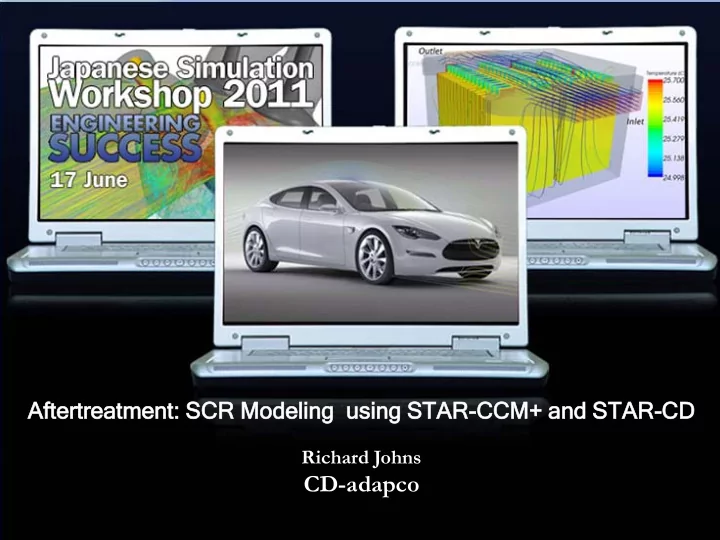

Aftertreat eatment ent: S SCR M Model elin ing g usin ing S g STAR-CCM CCM+ a and S STAR-CD CD Richard Johns CD-adapco
Contents SCR System Operation • Modeling Considerations • Validation: Spray and Catalyst Chemistry • Simple and Detailed Catalyst Chemistry • • Application to off-road SCR system Summary •
SCR System Operation Urea HNCO + H2O CO2 + NH3 hydrolysis (NH2)2CO + H2O Slow Fast NO NO NH3 (NH2)2CO HNCO + NH3 thermolysis NH 3 + NO +1/4O 2 N 2 +3/2H 2 O urea iso-cyanic acid ammonia NO Reduction MP = 130°C
Modelling Considerations • Unsteady: Engine exhaust flow and pulsed (typically 4 Hz) injection • Multi-component Urea + H 2 O - H 2 O evaporates and molten urea decomposes (thermolysis) to ammonia and isocyanic acid • Impingement & mixing Complex process involving impingement dynamics, wall-film and turbulent mixing • Chemistry: Gas-phase and catalyst surface reactions • Objective: To provide minimum dosing and achieve total NO reduction without either NO or NH3 slip
Validation Test Case upstream of SCR Catalyst Experimental Set up of Kim et al. (Proc. 2004 Fall Tech Conf ASME ICE Div.) to study the conversion • of Urea-Water Solution (UWS) into Ammonia UWS (40% Urea) is injected at the axis • Inlet gas Temperatures of 573, 623, 673 K were used at different average velocities from 6.0 – 10.8 • m/s thus yielding different residence times Rosin Rammler droplet distribution with average size of 44 microns and injection velocity of 10.6 m/s, • mass flow rate of 3.3e-4 kg/s, and injection temperature of 20 C Thermolysis Reaction (NH 2 ) 2 CO HNCO + NH 3 ; Rate = 4.9e3 exp (-2.303e7/RT) units in J, kmol, m, s Hydrolysis Reaction Upstream of SCR HNCO + H 2 O NH 3 + CO 2 ; Rate = 1.25e5 exp (-6.22e7/RT) units in J, kmol, m, s
Results – Mass Fractions & Temperature
Results – Uniformity Calculations Flow Direction is from left to right • Solid Cone Spray with 70 o , not much turbulent dispersion • Thermolysis consumes Urea quite rapidly • Conversion Efficiency & Uniformity Index of NH3 and H2O • can be deduced from this analysis.
Results – Comparison with Experiments (350 C) 1 1 Expt, Kim et al. Numerical Model Expt, Kim et al. Numerical Model 0.9 0.9 Gas Velocity = 6.4 m/s Gas Velocity = 10.8 m/s 0.8 0.8 0.7 0.7 NH3 Conversion NH3 Conversion 0.6 0.6 0.5 0.5 0.4 0.4 0.3 0.3 0.2 0.2 0.1 0.1 0 0 0 0.2 0.4 0.6 0.8 1 0 0.1 0.2 0.3 0.4 0.5 0.6 0.7 0.8 Residence time (s) Residence time (s) 1 1 Expt, Kim et al. Numerical Model Expt, Kim et al. Numerical Model 0.9 0.9 Gas Velocity = 9.1 m/s All Residence Times 0.8 0.8 0.7 0.7 NH3 Conversion NH3 Conversion 0.6 0.6 0.5 0.5 0.4 0.4 0.3 0.3 0.2 0.2 0.1 0.1 0 0 0 0.1 0.2 0.3 0.4 0.5 0.6 0.7 0.8 0 0.2 0.4 0.6 0.8 1 Residence time (s) Residence time (s)
Modeling of the SCR Catalyst The structured mesh in the axial direction represents multiple channels of the honeycomb structure in SCR. Select the following Physics Models 3D – Steady – Multi-Component Gas – Reacting – Non-Premixed Combustion – Homogeneous Reactor with – Surface Chemistry Chemistry ADI (with Surface – Reactions) Turbulent k-Epsilon –
Complex Reaction Mechanisms - DARS After import, STAR-CCM+ has the gas and surface species definitions, and reaction details. Ref: Dumesic et al., Journal of Catalysis , 163, 409-417 (1996)
Results – NO, NH3, V 3+ (s) fractions Flow Direction is from left to right • Mass Fractions at the inlet are uniform • [O2, H2O, NH3, NO, CO2, N2] = [0.11, 0.09, 0.01, 0.001, 0.073, 0.716] Standard post-processing quantities • can all be setup using reports in STAR- CCM+ and automated - Conversion Efficiency - Trapping Efficiency - Uniformity Index - NH3 Slip
Part (3.3) Reduce educed C d Chem hemistry Approac pproach F For or SCR A two-step Global Kinetics Model* has been adopted for • implementing surface reactions in SCR region The he rea eaction kinet netics was as dev developed for or a a V2O 2O5-WO3/ 3/TiO2 2 catalyst • The e honey eycomb b porous ous struc uctur ure e could d directly employ oy the propos oposed ed • kinet netic par parameters obt obtai ained from om the he kinet netic stud udy ov over a a pac packed-bed bed flow reac actor or In ST STAR AR-CCM+, the he rea eaction rat ates from om the he pape paper ar are mode odeled thr hrou ough • spec ecies es sour urce/sink nk terms prov ovided ded direc ectly in the SCR porous ous regions ons. * Ref: “ Direct Use of Kinetic Parameters for Modeling and Simulation of a Selective Catalytic Reduction Process” Chae et al., Ind. Eng. Chem. Res., 2000, 39
Two-Step SCR Model Kinetics Parameters
Results – NOx Reduction Comparison Two-Step Model Detailed Surface Chemistry
Summary STAR-CCM+ and STAR-CD have been developed to model SCR aftertreatment systems in detail All key phenomena – spray dynamics, impingement and wall film behaviour, multicomponent liquid, gas phase and surface chemistry are included Validation and testing against experimental data has demonstrated that accurate solutions can be obtained Application to aftertreatment system development is identifying areas for design changes and helping to develop optimized designs
Than hank Y You
Recommend
More recommend